The Surface 3 Review
by Brett Howse on May 4, 2015 9:00 AM ESTSystem Performance
Since the Surface 3 is a tablet that can replace your laptop, comparisons will be made between both devices. Because the new tablet is running full Windows 8.1 x64, it is possible to run the full benchmark suite that we have for laptops. On the tablet side, there are not a lot of cross-platform benchmarks so the only thing that can really be used is browser based tests. It is not ideal, but we have to work with what we have.
To summarize the Surface 3, it is powered by the top model of the latest Intel Atom 14nm stack. The Atom x7-Z8700 is a quad-core processor with a base frequency of 1.6 GHz. The CPU can turbo up to a maximum of 2.4 GHz, and all of this is done within a 2 watt Scenario Design Power. The review unit that I received is the $499 unit, so it only has 2 GB of LPDDR3 memory rather than the 4 GB offered on the higher priced model.
For comparisons against tablets, I have selected a sampling of several devices that have already been reviewed. Some of the devices are running on ARM processors, and several of the Windows ones run on Intel Core M, with a few more running on previous Atom architectures. To compare this device against any other device we have tested, please check out our Mobile Bench.
Tablet Performance
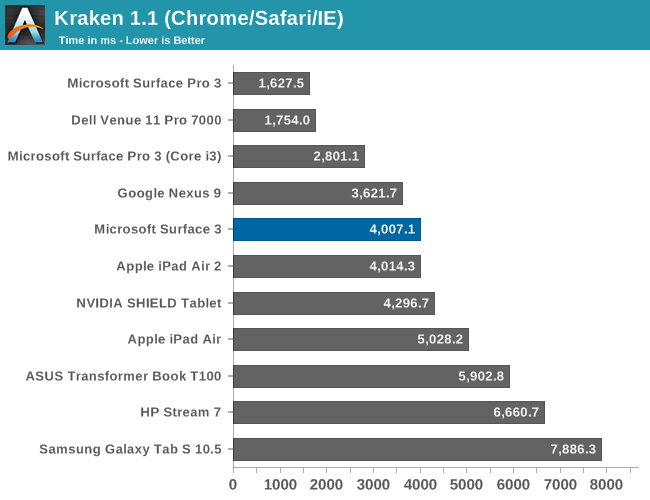
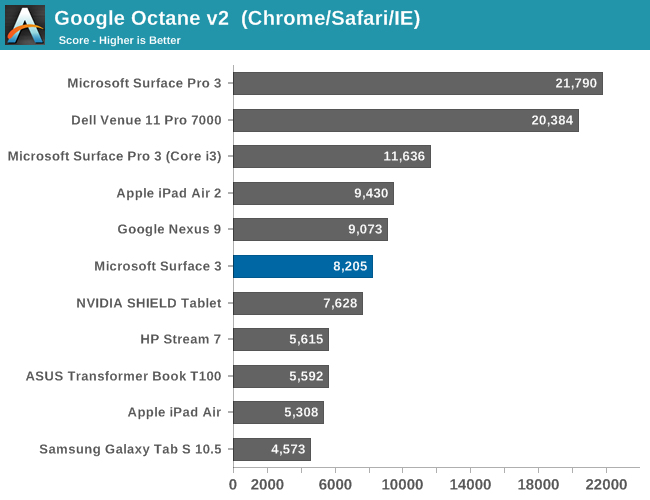

Since we just have web benchmarks to compare against other platforms, it does make it difficult to get a true feel for how Atom compares to the best, but when comparing to ARM processors it is fairly competitive. All of the web benchmarks are done using Chrome (hopefully we can switch to Microsoft Edge soon) because IE 11 has pretty awful javascript performance. Atom is a long ways off of the Core series in the Surface Pro line, and well back of the Core M powered Dell Venue 11 Pro tablet. There is a big jump in performance compared to the Bay Trail ASUS T100 and HP Stream 7. That is important since Cherry Trail is not a big architecture update, but mostly a process shrink, so the 14 nm processes can keep everything running at higher frequencies in the same power envelope.
Laptop Performance
By attaching the keyboard, the Surface 3 becomes a pretty reasonable laptop, so to see how much of a performance drop off there is with tablet class parts, the Surface 3 was run through our Laptop suite as well. The Atom is also equipped with eMMC storage, and some of the tests like PCMark take storage into account. Other benchmarks like Cinebench and x264 are CPU only. To compare the Surface 3 against any other laptop we have tested, please use our Laptop Bench.
PCMark

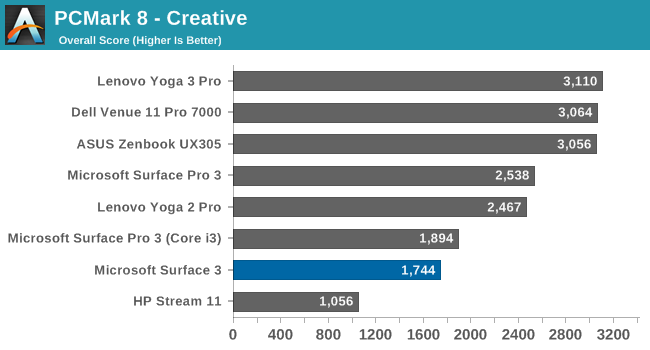
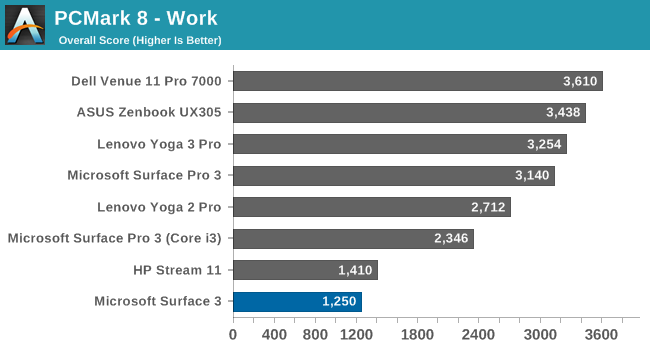
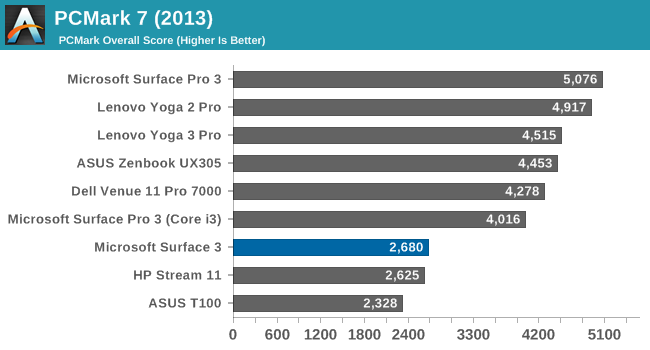
PCMark 8 from Futuremark has several benchmarks within it, all with the goal of simulating real-world use cases for each of the scenarios. It includes Home, Creative, Work, and Storage benchmarks. The workloads generally include both burst and sustained performance. The Atom can’t compete with the bigger Core pieces, but it is actually surprisingly close to the Core i3 Surface Pro 3. I think this is less about Atom and more about how handicapped Core i3 is with its lack of Turbo.
TouchXPRT


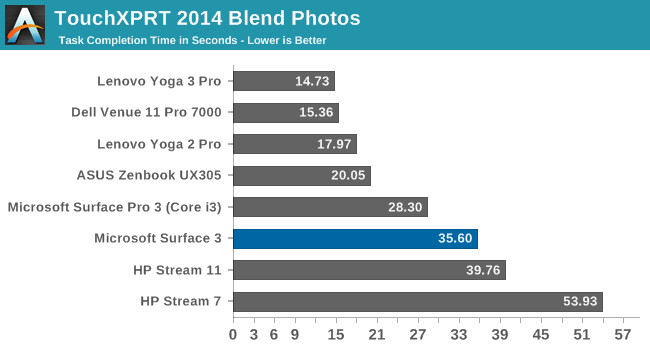
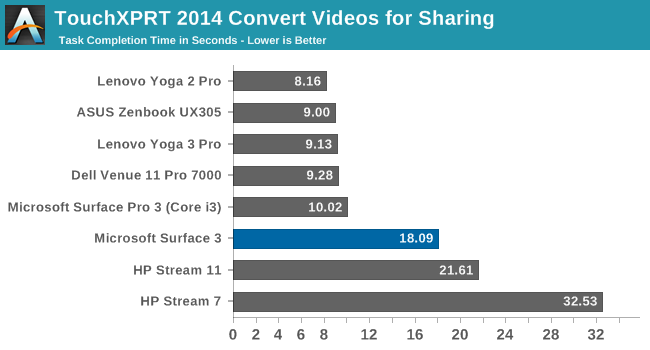
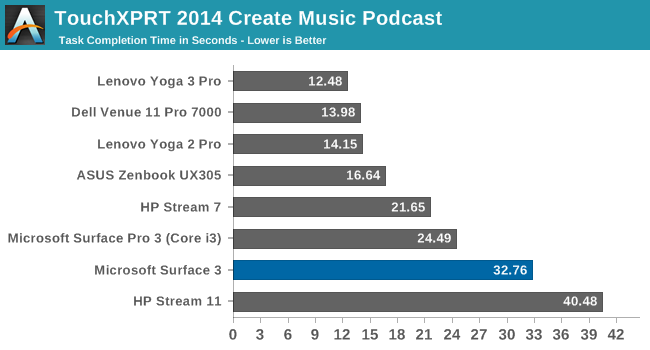
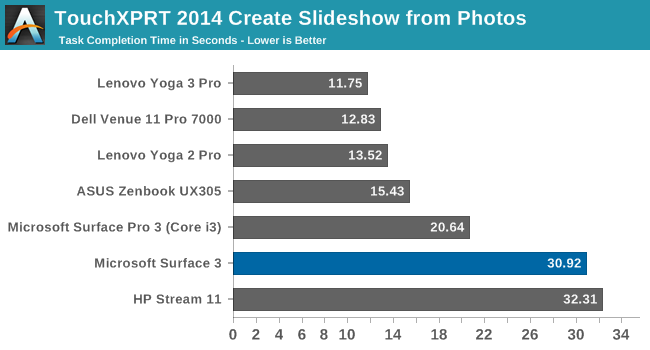
TouchXPRT 2014 is a benchmark that has a lot of burst workloads. The tasks are quick, but heavy, and it gives the processor a quick chance to cool off between each one so normally it is good about not running into throttling behaviour. The Atom processor is a long way off of the Core series here, with the exception of the i3 Surface Pro 3 which has no turbo capability. However there is a good bump in performance over the previous generation Atom in the HP Stream 7.
Cinebench

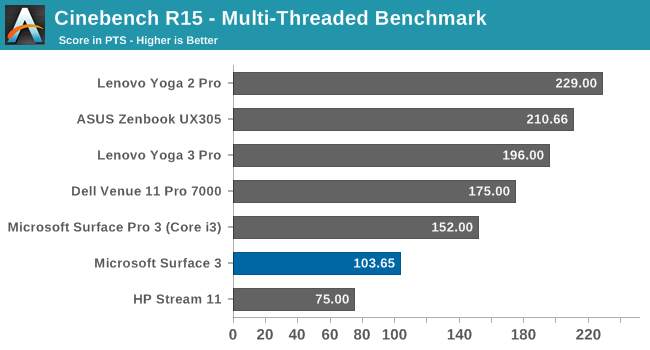
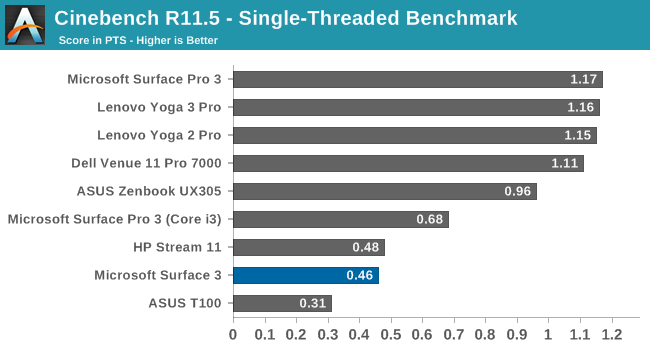
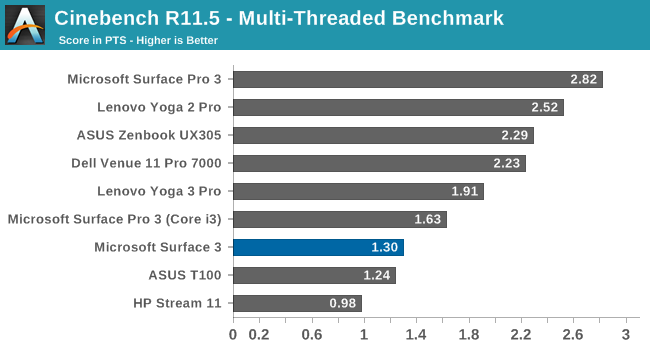
Cinebench is purely a CPU task, and it loves Instructions Per Clock (IPC) and frequency. There are two modes here with a single CPU run and all core run. It is still a long ways back of the Core i3 Surface Pro 3 on this test, and despite the Atom processor having four physical cores and the Core processors having only two physical and four logical cores, it is still not enough on the multithreaded run to really close the gap, although it does slightly. Looking at version 11.5 of this test, we have more data going back to older devices, so there are scores available from the ASUS T100 and there is a bump in performance compared to Bay Trail.
x264
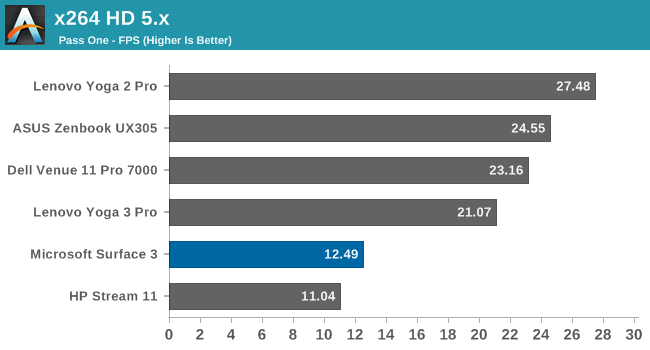

Once again this is a benchmark that prioritizes good IPC and frequency, along with multiple cores. The Atom struggles here compared to Core, which at this point should not be a surprise.
So clearly the new Cherry Trail CPU cores are not a giant leap in performance over Bay Trail, but like Haswell to Broadwell, there is a decent bump and the better manufacturing process helps increase overall performance due to the additional thermal headroom in the same power envelope. However when comparing it to the ARM competition, we only have a few data points but it does seem to be about on par with the top ARM CPUs at this time. Comparing devices across different operating systems is always difficult though.
Using the device day to day as a tablet though, performance was good. Yes, it could be better, and devices that use Core M are going to be able to run circles around Atom, but at the cost of additional heat. One of the nicest surprises of using this tablet was that it just never got warm at all, and the same cannot be said of any of the passively cooled Core M devices. Sure, when running very heavy benchmark loads, there was a bit of heat on the back, but it was never much more than around 30°C or so.
My experience was that when the Surface 3 felt slow, it was often not CPU bound but disk bound.










265 Comments
View All Comments
Brett Howse - Monday, May 4, 2015 - link
The battery in the Surface Pro 3 is 50% larger. 28 Wh vs 42 Whchizow - Monday, May 4, 2015 - link
That gulf will probably grow as well with the rumors SP4 may have a Core M variant. Cherry Trail is a bit disappointing though, not a huge increase in performance and this S3 actually has worst battery life than some of its Bay Trail predecessors like the Asus T100.Even more telling is the next slowest device in most of your tests is the $79 HP Stream 7, and while the Surface 3 certainly has more going for it in terms of form factor and functionality, a sub-$100 device is going to get a lot of passes where a $500 might not.
Shadowmaster625 - Monday, May 4, 2015 - link
That battery is the ultimate symbol of greed. Like they couldnt eat an extra $6 to give the thing a respectable battery. We need some explanation as to what exactly is the bottleneck in a game like DOTA 2. The <20 fps is extremely disappointing. but is it the GPU or the anemic CPU cores that hold it back? And why didnt they at least double the L1? Talk about greed.dullard - Monday, May 4, 2015 - link
"I’m not sure if we have found a “perfect” aspect ratio for a tablet"One aspect ratio would be nearly perfect for almost every use, if only tablet manufacturers would make a tablet at that aspect ratio. That nearly perfect ratio is 2^0.5 : 1 (about 1.414 : 1).
1) A program designed to fill the screen at 2^0.5 : 1 would also perfectly fill half the screen at 1 : 2^0.5/2 (which is still 1.414 : 1 when rotated). Finally, we could have distortion-free multi-tasking with no extra programming needed, an issue that no tablet has really yet solved.
2) It is a natural-feeling aspect ratio, not too tall or too narrow. No "narrow video" warnings needed. Webpages that haven’t been converted to mobile would still work well. It would have good hand feel.
3) It is almost exactly A4 paper ratio (1 : 1.41421 vs 1:1.41428). A4 is the standard paper for 2/3rds of the world. Thus a Word document, PDF, or similar would fill the screen uncropped. It isn't far off from from the US 11:8.5 paper standard either.
4) It is pretty much in the middle of the 4:3 digital camera and 3:2 DSL camera aspect ratios. That means when using the camera to see photos, it will look good with minimal cropping or black bars.
I could go on and on.
Jon Tseng - Monday, May 4, 2015 - link
>Having the third position really helps in a lot of situations, and while I would have liked the>final one to open as wide as the Surface Pro 3,
There is actually a fourth position. Give it a good shove and it collapses even flatter. Not sure if this is a genuine position or a manufacturing fail safe though!
Jon Tseng - Monday, May 4, 2015 - link
More details herehttps://www.reddit.com/r/Surface/comments/33rxja/s...I tried it on a demo unit in curry's. It works the stand is def engineered to open this far (whether its engineered to do it regularly I don't know)
gsusx - Monday, May 4, 2015 - link
Wtf. Curry's have them in stock. . Where?Jon Tseng - Tuesday, May 5, 2015 - link
The big Curry's on Tottenham Ct Road has a demo unit out. Had stickers on saying "property of Microsoft not sale stock" so presumably its a pre-release date demo unit. Yeah I was surprised to see it too!beggerking@yahoo.com - Monday, May 4, 2015 - link
micro usb type-c would be better , but a standard micro usb charging is still a huge leap forward vs any proprietary charging port.reversibility is for idiots. PERIOD.
kmmatney - Monday, May 4, 2015 - link
I take it you haven't used a reversible charging plug? It is a much better solution. Period.